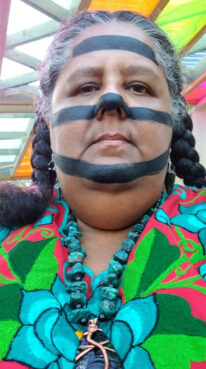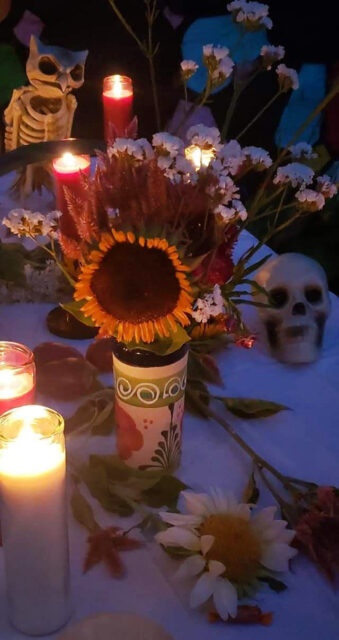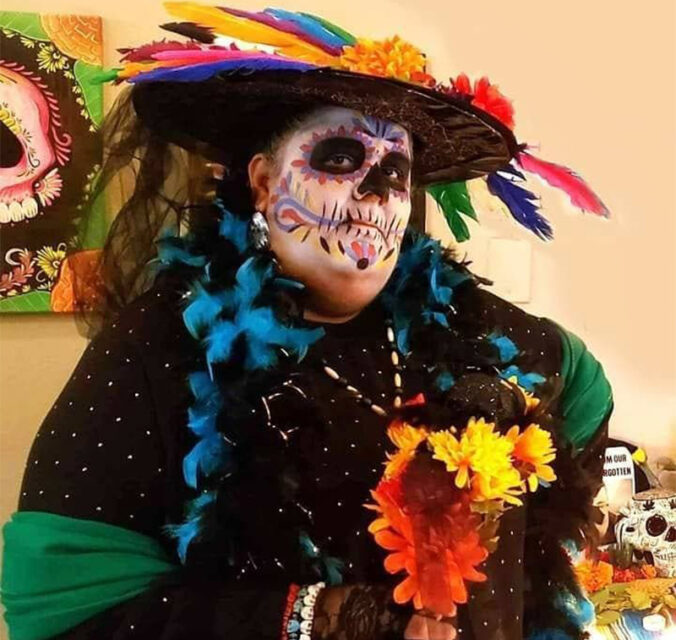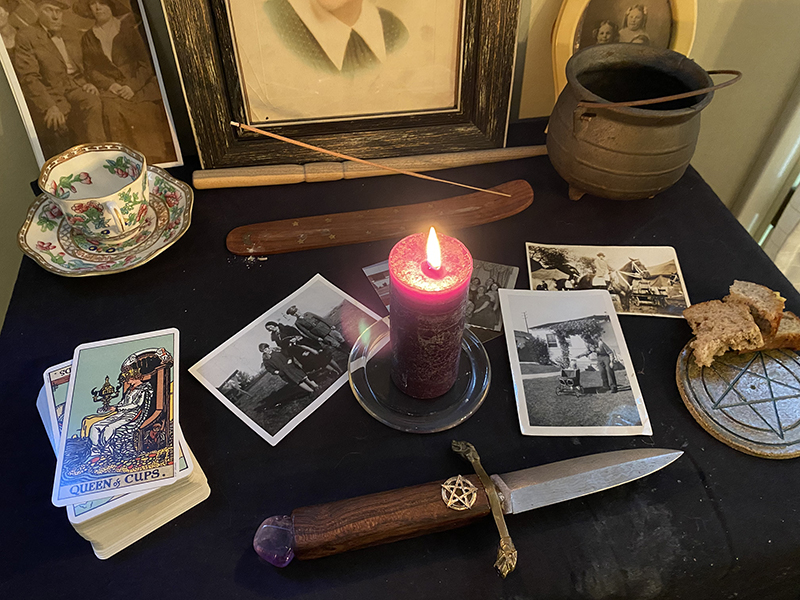(RNS) — As Americans of all faiths prepare for Halloween with costumes and candy or the Day of the Dead with food and flowers, the pagan community is also preparing for its holiday celebrating death and rebirth.
Samhain is the third and final harvest festival of the pagan Wheel of the Year, as the holiday calendar is known in many Earth-based religions.
“(Modern) Pagans have incorporated the seasonal concern with the dead in a holy day that celebrates the cyclicity of life, death, and rebirth,” writes folklorist and pagan scholar Sabina Magliocco in her book “Witching Culture.”
Not unlike the Day of the Dead and Halloween, Samhain (a Gaelic word pronounced “Sow-en”) includes feasting and honoring one’s ancestors, though those celebrating Samhain are likely to add some divination. Based largely on Irish folk religion, it is a time when the divide between the physical and spiritual worlds are believed to be thin.
RELATED: No, they do not worship the devil, and other myths dispelled in new book on satanism
The Rev. Laura González, who is a practicing witch and a pagan educator and podcaster in Chicago, celebrates all three. “(My practice) is a hodgepodge,” she laughs.

The Rev. Laura Gonzalez celebrating Tlaxochimaco 2022 in Little Village, Chicago. Courtesy photo
González merges modern paganism with Mexican traditions, including practices indigenous to central Mexico, where she is from. “At their core, modern paganism and these indigenous practices both honor the Earth,” she said. Nature reverence is essential, she said, to her spiritual path.
“Let me describe to you what happens in my life,” González said in a phone interview. On Oct. 1, the decorations go up for Halloween, a purely secular holiday for her. Then, around Oct. 27, she sets up a Day of the Dead altar to honor deceased relatives, as most Mexicans do about this time, she said. “My mother died on Oct. 27, 2011. I believe it was her last wink to me,” said González.
Since then, González has been honoring her mother with bread and coffee but has also made it her mission to teach others about the Day of the Dead and its origins. She teaches those traditions as well as modern paganism both locally and over the internet at the pagan distance-learning Fraternidad de la Diosa in Chihuahua, Mexico.
On Samhain, González always hosts a small ritual for her Pagan students and participates in Samhain celebrations, either as an attendee or organizer. Some years she travels to Wisconsin to be with fellow members of the Wiccan church Circle Sanctuary.
Samhain is traditionally honored on Oct. 31, but some pagans celebrate it Nov. 6 or 7, an astrologically calculated date. Regardless, group celebrations must often yield to modern schedules, and González said she will celebrate an early Samhain this year.
“My (Samhain) celebration is for the ancestors and for the Earth going into slumber — the Goddess goes to sleep,” González said. She likes to focus her ritual on modern pagan trailblazers, often referred to as “the mighty dead,” rather than on her relatives, which she honors on the Day of the Dead.
González’s central Mexican indigenous practice and her modern pagan practice, rooted in northern Mexico and the United States, “are very similar,” she added, both honoring the Earth and “us as individuals as part of nature,” something she believes has been lost in modern Day of the Dead traditions. However, she quickly added, “Indigenous practices are not pagan.”
Growing up in Mexico City, González was surrounded by mainstream Mexican culture, with Day of the Dead festivals and altars. As she was exposed to the Indigenous traditions that are still woven through Mexican culture, she explained, she began to study folk magic and traditions, as well as “Native philosophies.”
The Day of the Dead, she said, “is the ultimate syncretic holiday,” a merger of the European-based Catholic traditions with Indigenous beliefs and celebrations. “The practices brought to Mexico by the Catholic colonizers were filled with pagan DNA,” she said. All Saints’ Day and All Souls’ Day contain remnants of traditional Samhain and other older beliefs, she noted.
“These colonizers came to a land filled — filled — with skulls and its imagery,” she said, which must have been frightening and somewhat of a culture shock, she added.

An altar during Tlaxochimaco 2022 commemorations in Chicago. Courtesy photo
González is now actively participating in the revival of the Indigenous traditions as a teacher and celebrant. The Indigenous holiday, she said, is a 40-day celebration. The first 20 days is called Tlaxochimaco, or the birth of flowers, and the second is Xoco Huetzi, or the fall of the fruit.
“We all are flowers,” she explained. We grow, flower, bloom and then become fruit. Eventually falling and becoming seed, and the cycle continues. The Aztecs “used this mythology to describe life and life cycles,” she said.
“But there are people who do not make it to fruit. They die young,” González explained. These people are honored during Tlaxochimaco.
During Xoco Huetzi, celebrations are held to honor those who have made it to old age before passing. Both festivals traditionally involve dancing, she said, which is considered an offering to the dead.
The 40-day celebration was eventually condensed into two days aligning with the colonizers’ Catholic traditions, she said, becoming the modern Day of the Dead celebration, a holiday that is quickly becoming as popular north of the Mexican border as Halloween is.
While González is not offended by purely secular Halloween celebrations, even with its classic depiction of witches, she struggles with the growing commercialization of the Day of the Dead. “I know what I am, and I know what I celebrate,” she said, speaking of Halloween. “I find it funny that the wise woman has been made into something scary.”
What does offend her is people dressed as sugar skulls. “It’s a double-edged sword,” González said. “It’s a source of pride knowing the world loves our culture,” she said. However, she added, “You love our culture, you love our music, you love our food, you love our traditions, you love our aesthetics, you love our parties and holidays, you love all of that, but you don’t love us.”
RELATED: The most recognizable work at the Whitney Museum’s new modernism exhibit may be a tarot deck
This is the definition of cultural appropriation, she added.
“The world is filled with racism, discrimination, colorism, classism,” she continued. “There is a disconnection between the thing and the people who made the thing.” She likened this to a second wave of colonization.
Her recommendation: “If you like Day of the Dead stuff,” she said, “shake a tree and a Mexican artisan will fall from it. Buy Mexican. You will benefit the very people who have created the aesthetic,” she said. “The big box stores don’t need your money,” she said, but Mexican and Mexican American families do.
Many pagans, especially in the growing Latino pagan community, do honor multiple traditions like González, particularly around the time when the holidays align.
“I think it’s important to recognize where we come from and how we survive whatever challenges our ancestors had,” said González. Samhain, Day of the Dead and the Aztec traditions “are, after all, a celebration of life and their lives.”






